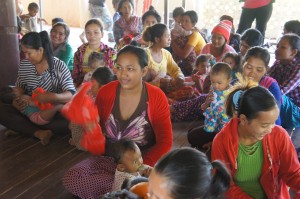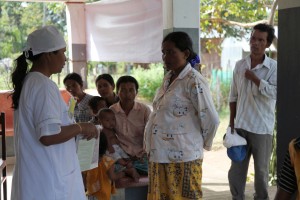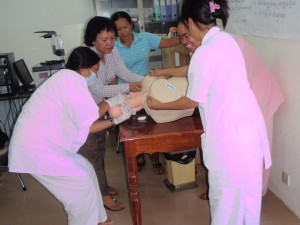Maternal and Child Health Improvement Phase II
 PHJ’s present project site, Kampong Cham Province, is the most populated province in Cambodia with the largest number of health centers 142 also. However, there is no registered midwife in 22 centers where assistant midwife receiving only one year training after graduating from a high school are serving. The province has the problem of lack of human resources with adequate knowledge and practical medical services who can be leaders on the practical level.
PHJ’s present project site, Kampong Cham Province, is the most populated province in Cambodia with the largest number of health centers 142 also. However, there is no registered midwife in 22 centers where assistant midwife receiving only one year training after graduating from a high school are serving. The province has the problem of lack of human resources with adequate knowledge and practical medical services who can be leaders on the practical level.
PHJ is extending maternal and child health improvement at the Steung Trang Health District. According to the statistics of the district health center, the number of health checks of a pregnant woman, child birth and postpartum checks at the health center is decreasing. The issue of the district is the lack of adequate health care services such as periodical checks of pregnant women, delivery, postpartum checks, family health care.
Since the Steung Trang Health District is a new administrative district and the supervisory system from the health district to the lower level is not firmly established. In order to enhance the maternal and child health improvement in such district, administrative and supervisory functions enhancement is urgently required.
To extend the continued health care to mothers and children, PHJ will proceed with building the system where the health center midwives would extend services under the trust from the villagers.
This project is put into practice by the support from the Ministry of Foreign Affairs Japan NGO cooperation grant aid, Narita Cosmopolitan Rotary Club, Yagami Co. LTD., and other supporter companies, groups, and individuals.
Maternal and Child Health Improvement Phase I
 PHJ’s project site Kampong Thom is geographically widely spread but population is rather small (46 persons/sq. km). There are only three provincial hospitals and 50 health centers. So the residents in remote areas have difficulty in accessing medical and health facilities. PHJ has been implementing matrnal and child health improvement projects in these rural areas. The projects started in 2008 and presently the Phase II Project is underway.
PHJ’s project site Kampong Thom is geographically widely spread but population is rather small (46 persons/sq. km). There are only three provincial hospitals and 50 health centers. So the residents in remote areas have difficulty in accessing medical and health facilities. PHJ has been implementing matrnal and child health improvement projects in these rural areas. The projects started in 2008 and presently the Phase II Project is underway.
In Phase I, the focus was on the improvement of quality of maternal and child health service and usage of the service by villagers. The Phase I project was successfully completed increasing the number of pregnant women taking periodical checks and assiatance of midwives in delivery. In Phase II, the goal is to increase the visit to health center and villagers building health care system such as sanitary conditions and other aspects of the maternal and child health care.
Maternal and Child Health Volunteers
Village health volunteers, leaders of mothers and other village human resources are trained as key persons in maternal and child health. After training, maternal and child health volunteers in cooperation with the concerned health center visit pregnant women/new borns to give advice on daily care and periodical check at health center
Clean Water and Healthy Life
In the Phase II project, villagers receive health education on practical health matters such as village cleaning campaign and securing safe drinking water to lead healthy lives. To implement this education, model households are selected to install toilets and to practice health improvement. These households receive health education and are expected to introduce health concept and benefits of healthy life to other villagers.
Promotion of Health Education
Village health volunteers in cooperation with health center extend villagers collective maternal and child health improvement education. The education program consists of information on the nature of health center services and how to keep maternal and child health care management using health picture slide show and other easy to understand methods.
Village and Health Center Network Improvement
Cooperation of villagers and health center is indispensable for the villagers to maintain healthy lives and for the health center to extend appropriate health services effectively and efficiently. For this purpose, PHJ encourage health volunteers, maternal and child health volunteers, traditional birth attendants and health center network to exchange information and continuously work for the maternal and child health improvement.
Access to Health and Medical Facilities for Expected Mothers
In rural areas, it is difficult to secure access to carry emergency patients to medical facilities. So PHJ is helping the villagers to build a transportation system. This system is intende for villagers to have an access between village and health center and health center and hospitals and manage the system by themselves. Village office and health administration are taking initiative to form a transportation committee in villages.
Training of Midwives
 PHJ’s training of midwives project is directed to the midwives of health centers who are expected to become key persons for the local maternal and child health care service. This training consists of one month practical training at hospitals aiming at midwives able to provide appropriate maternal and child health care focusing assistance at delivery.
PHJ’s training of midwives project is directed to the midwives of health centers who are expected to become key persons for the local maternal and child health care service. This training consists of one month practical training at hospitals aiming at midwives able to provide appropriate maternal and child health care focusing assistance at delivery.
The project started in May 2006, at Prey Veng Province on trial basis. The Provincial Health Department highly evaluated this trial training and requested PHJ to extend the project period. By July 2012, PHJ has implemented 16 trainings and 32 midwives received the training. After the trainings, the nidwives have improved their skills and so the number of child birth attended by midwife is increasing.
Recognizing the achievements in the Prey Veng Province, Kompong Thom Province requested PHJ to extend the training of midwives.
Training Program
The training aims at midwives stationed at health centers acquiring knowledge and skills sufficient to provide proper maternal and child health care services.
One month training at hospital consists of lectures and practical training by medical doctors and midwives of hospitals plus follow-up training as mentioned below.
These trainings have proven effetive in building confidence among the trainees.
Follow-up Training
The trained midwives extend maternal and child health care services including attendance at delivery at health centers. The training at hospitals as well as the follow-up training are effective in establishing cooperation between the health centers and hospitals. For example, a trained health center midwife visits a hospital for advice and attends a pregnant woman during transportation to a hospital as a responsible staff.
2011 Flood Disaster Support (Project period: October 2011~February 2012)
Starting August 2011, the Indo-China region suffered flood damages due to continued strong rains, which affected 5.7 million people across five countries. PHJ made donations to assist the flood victims in Cambodia and Thailand.
In Cambodia, Kampong Thom Province, PHJ’s maternal and child health care improvement project site, was hit by the flood seriously. PHJ made emergency support and distributed to 5,704 households the sanitary kits consisting of two soaps, two towels, kitchen detergent, two scrubbs, three garvage bags, and one skin ointment. When distributing the sanitary kits, PHJ staffs provided health education such as washing hands.
PHJ Cambodia Office is visiting the disaster areas periodically after the flood receded. Particularly the farmers whose rice fields were flooded are suffering from the lack of food and income. Many farmers left the villages to earn money at other places. Although the flood receeded, damages to poor families are serious. PHJ continues to support the flood disaster areas.
Strengthening Health Center Function (2005-2007)
PHJ has been implementing maternal and child health care service project at Kompong Thom Province, rural area where the health conditions are poor. To improve the conditions, PHJ decided to implement the health center function empowerment project to encourage villagers to use maternal and child health care services of the health center. Starting 2005, PHJ started a strengthening of the health center function project at Kampong Thom Operational Health District (OHD). At the completion of the project, PHJ conducted a survey on the requirements and found the Baray-Santuk OHD would be the next project site and started the Maternal and Child Health Improvement Project Phase I.
Maternal and Child Health Improvement Project Phase I (2008~2010)
Phase 1 project aims at villagers making effective use of maternal and child health care services at health centers. PHJ extends training to the health center staffs to provide effective service, management of the health center, training of village health volunteers, and network building between villagers and health centers.
Evaluation Report・・・・Visit to and use of health centers by villagers increased. Delivery attendance by health center midwife was 2% prior to the Phase 1 project and at the completionof the project the rate increased to 77%. The reasons for the increased visit to and use of the health center is attributed to villagers’ recognition of the importance of maternal and child health care and periodic check of pregnancy on one hand, and improved service by the health center midwife and other staff. (Evaluation Report)
Ultrasound Medical Equipment Image Diagnosis Training (April 2007~June 2010)
In order to enhance image diagnosis skills of obsteric and gynecologist specialists of Cambodia in basic diagnosis of maternal and child health with ultrasound medical equipment, PHJ requested a Japanese obsteric and gynecologist specialist to provide training to six doctors of Phnom Pen City Hospital. The training consisted of confirming embryo status, diagnosis skill training to provide appropriate treatment, and early diagnosis of women’s diseases. Due to the lack of basic health and medical education in Cambodia arising from the long lasted civil war, the training was extended for three years. During the training, the trainees were able to build a network of medical doctors to share knwoledge. For example, they made records of various cases in a same format to share the data. Through such medical network and system building, Cambodian doctors knowledge and skills enhanced considerably. One purpose of training is to accelerate the level of medical doctors in Cambodia. The trained Cambodian doctors are now able to act as lecturers.
